When I picked up my mail after arriving in D.C. from Cape Town a couple of weeks ago, I found to my surprise that I have been a New Yorker subscriber since September. My first reaction: “Oh, look, a giant pile of guilt!” Then I saw the brightly colored covers, and I wanted to gather them all in a slippery embrace, like fellow survivors from a lost world. Few things from 100 years ago bring me as much joy as magazine covers, and few things (well, few non-news-related things) are as dispiriting as a 2020 magazine rack.
I had a post on February 1920 covers almost ready before I left Cape Town, but what with all the electricity cuts I didn’t manage to post it. So I’m covering both February and March here.
The February magazines feature lots of women engaging in wholesome outdoor activities like skiing,
snowshoeing,
and pathetic ice skating.
And also engaging in unwholesome outdoor activities like this:
The artist for this surprisingly risqué cover is Warren Davis. He also drew this February 1918 Vanity Fair cover,
which I took note of back in February 2018. That one was also daring, but it struck me as having that Greek mythology vibe that lets you get away with anything. It turns out, though, that young women cavorting around outdoors naked, or at most with a diaphanous scarf, comprise pretty much Warren Davis’ entire oeuvre.*
Some favorite artists are back: Frank Walts at The Crisis,
Helen Dryden at Vogue,
A.M. Hopfmuller at Shadowland,
and, as always, Erté at Harper’s Bazar.
There’s a Valentine’s theme at Red Cross
and at Smart Set, which I’m pleased to see breaking out of its face-of-young-attractive-woman rut.
There are people in traditional dress at Sunset
and Liberator
and World Outlook.
I loved these covers from House & Garden
and Popular Mechanics
and Elite Styles.
As I prepared for my trip, I was all psyched up to leave the southern hemisphere summer for some outdoor winter fun. Of course, what I actually ended up doing was lugging groceries home in the rain. So good riddance to February…
…and onward to blustery March!
They’re getting in some late-season ice skating at Red Cross**
and some early-season boating at Motor Boating.
Am I reading this wrong or is this elephant being used as an accessory to kill other elephants?*** And don’t get me started on the African man in the loincloth.
Everybody’s is late to the Valentine’s Day party.
Vogue has a cover by regular George Wolfe Plank
and one by 26-year-old newcomer Harriet Meserole, who would go on to be a Vogue stalwart.****
Bright spring colors abound at Harper’s Bazar
and The Delineator
and The Green Book
and House & Garden
and Shadowland
and Vanity Fair, which features a cover by Anne Harriet Fish, an artist whom I wasn’t familiar with but who will now join Gordon Conway and John Held Jr. in the ranks of VF artists whose work I can’t tell apart.
Future New Yorker cartoonist Rea Irvin was the artist for this striking, though problematic to modern sensibilities, Life cover.
This woman on the cover of the Saturday Evening Post seems to be about to ditzily cast her first vote for the supposedly more handsome candidate, which I would take offense at, except, um, Warren Harding.*****
The woodcut on the cover of Liberator is by J.J. Lankes, who was a friend of, and illustrator for, Robert Frost and Sherwood Anderson.
This Photoplay cover isn’t particularly notable except that “If Christ Went to the Movies” is the best cover headline ever.******
And it wouldn’t be March without a lion and a lamb, courtesy of Carton Moore-Park:*******
Counting the days until spring!
*Google him if you don’t want to take my word for it. Just don’t do it at the office.
**According to the go-to site for Norman Rockwell cover information, this was Rockwell’s fourth and last cover for Red Cross, which folded in late 1920. Rockwell turned to smaller magazines when large-circulation magazines passed on his illustrations.
***I always thought you couldn’t ride African, as opposed to Asian, elephants. Apparently you can, although, according to animal rights advocates, you shouldn’t.
****As far as I can tell, this is Meserole’s first Vogue cover other than this February 1919 one, which is mostly white space:
*****Also, the cover artist, Neysa McMein, was a woman and an ardent supporter of gender equality. Here she is marching in a suffragist parade in 1917.
******Excerpt:
*******Moore-Park also drew the “is it a lady or a parrot?” August 1919 LHJ cover.


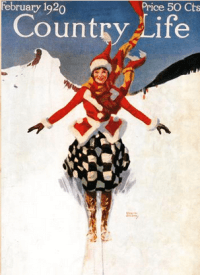
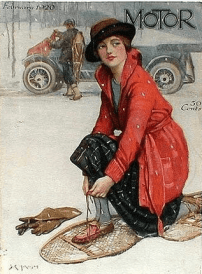
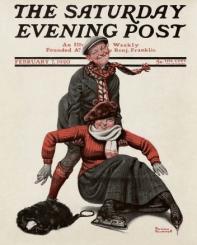
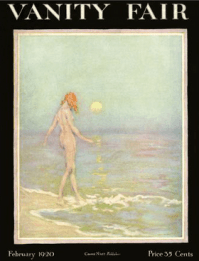


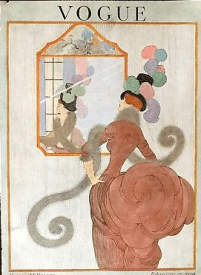
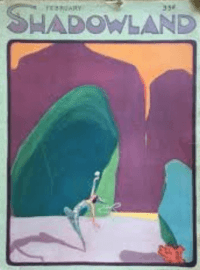
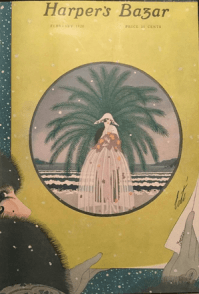


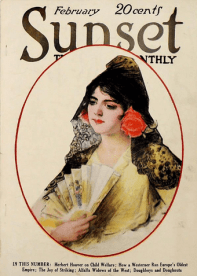
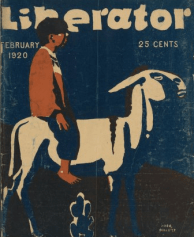


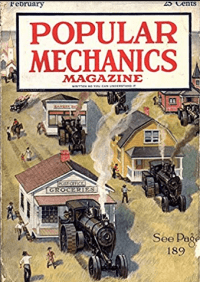
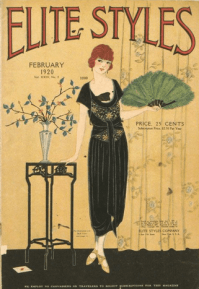
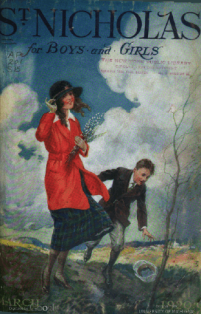
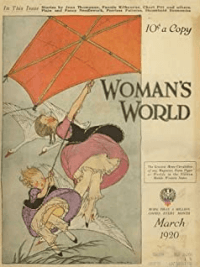
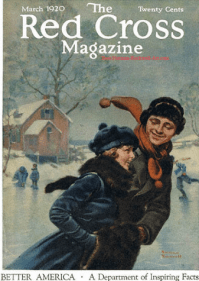

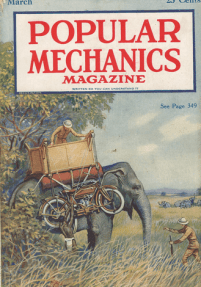

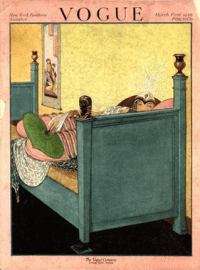

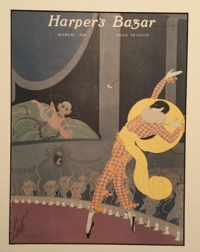
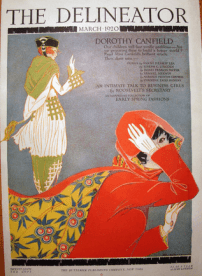
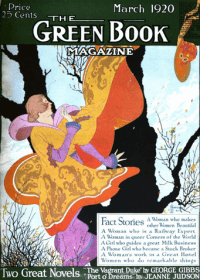
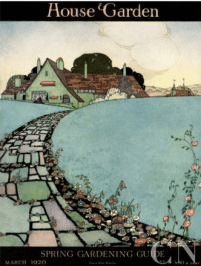
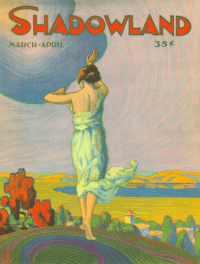
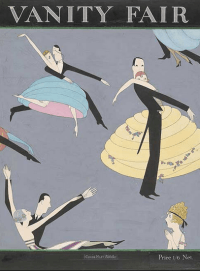
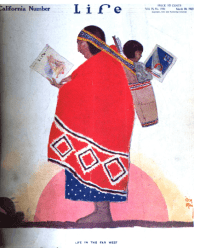
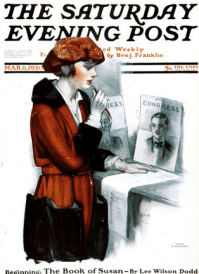
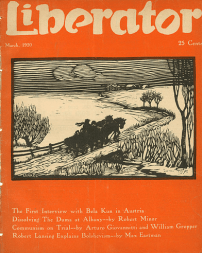

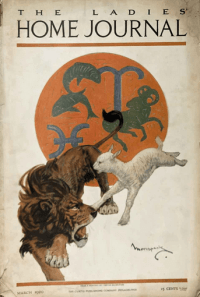


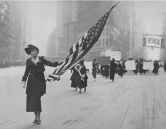

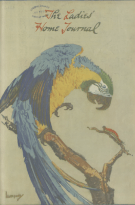
What a nice surprise to see the Popular Mechanics cover of housemovers at work! My father and his father were housemovers. “Housemover” is one of those words that has a different meaning in Britain and America; in England a housemover moves furniture, but in the USA , they move entire buildings. (The U.S. has many wooden buildings….) My father and my Uncle Bert were dedicated readers of Popular Mechanics and contributed to my education by discussing various articles at the dinner table. I do hope they saw that cover in 1920. My father would have been almost 16 — and already moving houses — when it came out. I also note that the “elephant” cover illustrates the failure of the motorcycle, perhaps annoying some mechanics among its readers. Thank you for another morning of time travel!
LikeLike
I loved the house-moving cover–it was my favorite of this roundup. Fascinating about your father and uncle being house movers! I should check out the accompanying article. On the elephant cover, I thought they were taking down the motorcycle, not hauling it up, but your interpretation makes more sense. Either way, as someone with some experience in the African bush, a motorcycle strikes me as a dubious means of transport.
LikeLike
You are likely the only blog I follow were I can find out the rideability of African vs. Asian elephants.
I too liked the Popular Mechanics house-mover cover. I was trying to compose snarky captions the moment I saw it. The best so far:
“Did you know that Amazon.com started in 1920 with a slightly different business model?”
I was also struck by The Green Book and Shadowlands, both of which have unusual periodical titles and seem to have a striking house style. The Green Book “Women who do remarkable things” has 1920 clickbait titles in the “Fact Stories” box too. “The Woman who is a Railway Expert. A Phone Girl who became a Stock Broker.” Both were apparently aimed at women and included theater and arts coverage.
LikeLike